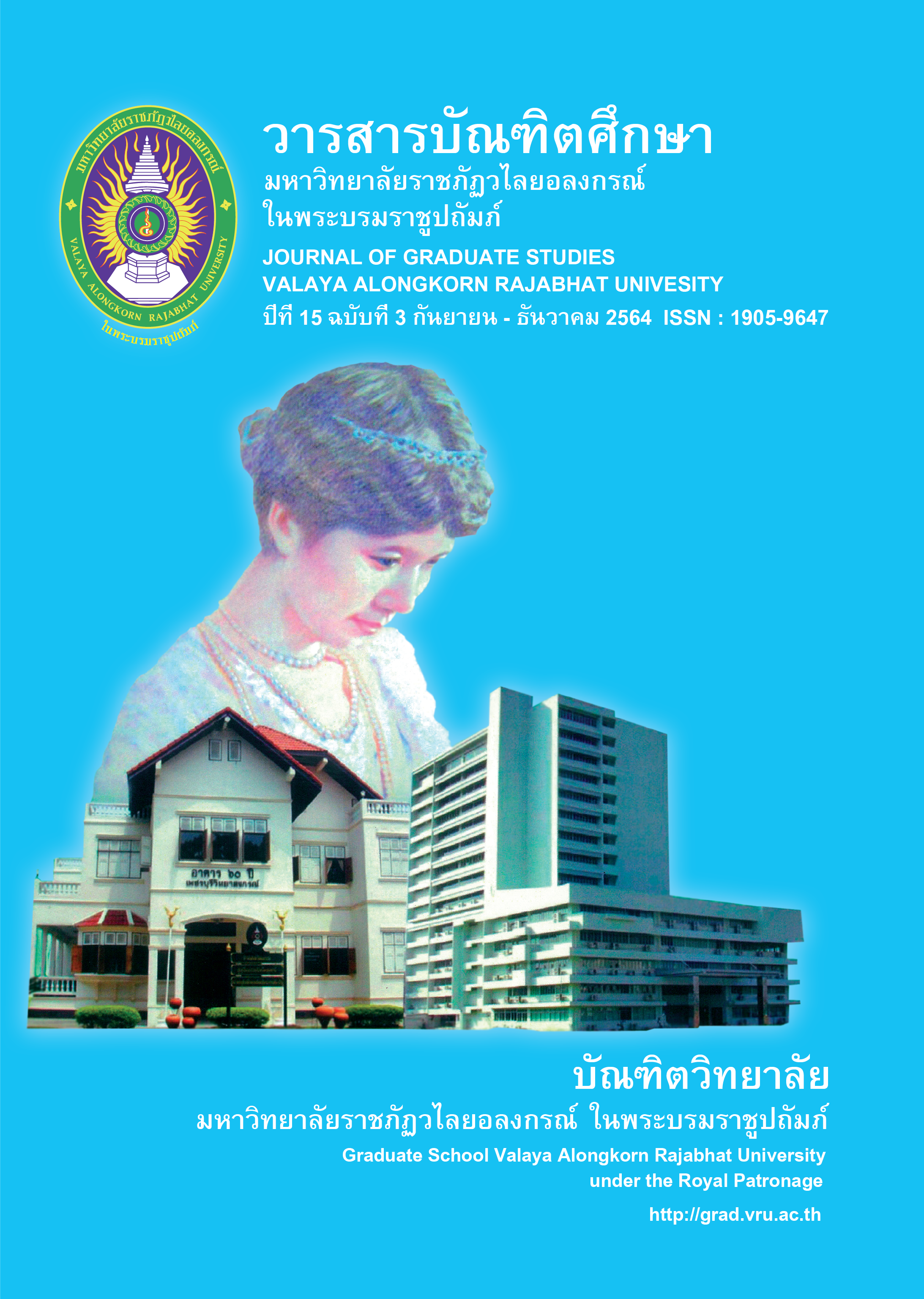THE EFFECTS OF MATHEMATICS LEARNING ACTIVITIES ON TWO-DIMENSIONAL AND THREE-DIMENSIONAL FIGURES BASED ON THE CONSTRUCTIVISM THEORY ON MATTHAYOM SUEKSA ONE STUDENTS
Main Article Content
Abstract
The aims of this quasi-experimental research were 1) to study the effects of organizing mathematics learning activities for efficiency learning results according to 80/80, 2) to compare not only the student’s academic achievement before and after using the organizing mathematics learning activities on Two-dimensional and Three-dimensional Figures for Matthayom Sueksa One students based on the Constructivism theory, and 3) to study the students satisfaction with the learning activities based on the Constructivism theory. The research sample were a class of 35 Matthayom Sueksa One students in academic year 2019. The researchers used clustered random sampling in this research. In addition, the research instruments were (1) the academic achievement test, which the difficulty level, discrimination level, confidence interval level, was .21-.80, .202-.675 and .892 respectively. (2) The satisfaction of students towards organizing learning activities evaluation form, which the reliability of Cronbach alpha was .887. (3) The organizing learning activities, which the consistency index value (IOC) were 0.67-1.00. The statistics used in data analysis were mean, percentage, and standard deviation. The technique of dependent t test was used to test the hypothesis.
The finding were: (1) The learning activities had an efficiency of 83.45/81.76 in accordance with the set criterion efficiency of 80/80. (2) The academic achievement of the students was higher after the study than prior to the study at the statistically significant level of .05. (3) The student satisfaction with the learning activities overall was at a high level.
Article Details
บทความทุกเรื่องได้รับการตรวจความถูกต้องทางวิชาการโดยผู้ทรงคุณวุฒิ ทรรศนะและข้อคิดเห็นในบทความวารสารบัณฑิตศึกษา มหาวิทยาลัยราชภัฏวไลยอลงกรณ์ ในพระบรมราชูปถัมภ์ มิใช่เป็นทรรศนะและความคิดของผู้จัดทำจึงมิใช่ความรับผิดชอบของบัณฑิตวิทยาลัย มหาวิทยาลัยราชภัฏวไลยอลงกรณ์ ในพระบรมราชูปถัมภ์ กองบรรณาธิการไม่สงวนสิทธิ์การคัดลอก แต่ให้อ้างอิงแหล่งที่มา
References
Chaonahi, N., Chansila, A., & Sri-Ampai, P. (2011). kānphatthanā kitčhakam kānrīanrū khanittasāt tām nǣokhit thritsadī khō̜n satraktiwit rư̄ang sētsūan chan prathomsưksā pī thī hok [Developing Mathematics learning activities based on the Constructivist theory entitled “Fractions” for 6th grade education]. Rajabhat Maha Sarakham University Journal. 5(1), 163-174.
Glasersfeld, V. E. (1989). Constructivist in education in the international encyclopedia of education: Research and studies. New York: Progamon.
Khumun, S. (2015). kānphatthanā kitčhakam kān rīan kānsō̜n khanittasāt tām nǣokhit thritsadī khō̜n satraktiwit rư̄ang lamdap læ ʻanukrom chan matthayommasưksā pī thī hok rōngrīan sāthit Mahāwitthayālai Rāmkhamhǣng [The development of Mathematics instruction and study activities on Sequences and Series based on Constructivist theory for matthayom sueksa six students at Ramkhamhaeng University Demonstration School]. Master’s thesis. Ramkhamhaeng University.
Makanong, A. (2003). kānsō̜n læ kānrīanrū [Mathematics teaching and learning]. Bangkok: Chulalongkorn University.
Martin, R. E., Sexton, C., Wagner, K., and Gerlovich, J. (1994). Teaching science for all children. Boston: Allyn and Bacon.
Ministry of Education. (2010). nǣothāng kānčhatkān rīanrū tām laksūt kǣn klāng kānsưksā naphư̄n thān Phutthasakkarāt sō̜ngphanhārō̜ihāsipʻet [Learning management based on basic education core curriculum B.E.2551 (A.D.2008)]. Bangkok: The Agricultural Cooperative Federation of Thailand. Limited.
Ministry of Education. (2017). tūa chī wat læ sāra kānrīanrū kǣn klāng klum sāra kānrīanrū khanittasāt (chabap prapprung Phō̜.Sō̜. sō̜ngphanhārō̜ihoksip) tām laksūt kǣn klāng kānsưksā naphư̄n thān Phutthasakkarāt sō̜ngphanhārō̜ihāsipʻet [Indicators and core learning areas subject area of Mathematics (Revised edition B.E. 2560) based on basic education core curriculum B.E.2551 (A.D.2008)]. Bangkok: The Agricultural Cooperative Federation of Thailand. Limited.
National Institute of Educational Testing Service (Public Organization). (2019). rāingān phonlakā rot da sō̜p thāngkān sưksā radap chāt khan phư̄nthān (O - NET) chan matthayommasưksā pī thī sām pīkānsưksā sō̜ngphanhārō̜ihoksipʻet [Ordinary National Educational Test report]. Retrieved from http://www.newonetresult.niets.or.th/AnnouncementWeb/PDF/SummaryONETM3_2561.pdf
Pareepan, S., Muangchan, S., & Chaichana, S. (2011). kānphatthanā kitčhakam kānrīanrū klum sāra kānrīanrū khanittasāt tām nǣokhit khō̜n satrakti wisưm rư̄ang phư̄nthī phiu læ parimāt chan matthayommasưksā pī thī sām [Development of Mathematical learning activities based on Constructivism entitled “Surface area and Volume” for mathyom suksa 3]. Journal of Curriculum and Instruction Sakon Nakhon Rajabhat University. 3(6), 17-23.
Pimsiri, B., & Uamcharoen, S. (2018). kānphatthanā rūpbǣp kānčhatkān rīanrū tām nǣokhit Constructivism phư̄a songsœ̄m khwāmsāmāt thāng khanittasāt khō̜ng nakrīan chan prathomsưksā [The development of learning model based on Constructivism to enhance Mathematical abilities for students in primary]. Veridian E-Journal, Silpakorn University. 11(1), 616-632.
Shelly, M. W. (1975). Design as an Instrument of Change: The Rule of Design in Two Responding to Social Change. Pennsylvania: Dowden Hutchison & Ross.
Singmuy, C., & Nilsrakoo, W. (2017). khwāmsāmāt nai kānhai hētphon thāng khanittasāt phān kitčhakam kānrīanrū khanittasāt bǣp būranākān tām thritsadī khō̜n satraktiwit rư̄ang khwām nā čha pen [Competence on probabilistic reasoning using integrated learning activities based on Constructivist theory]. In kān prachum wichākān thāng khanittasāt khrang thī yīsipsō̜ng pračham pī sō̜ngphanhārō̜ihoksip [The 22nd Annual Meeting in Mathematics 2017 (AMM 2017)]. (pp.1-13). Chiang Mai: Department of Mathematics, Faculty of Science, Chiang Mai University.
The institute for the Promotion of Teaching Science and Technology. (2017). khūmư̄ kānchai laksūt klum sāra kānrīanrū khanittasāt radap chan matthayommasưksā tō̜n ton (chabap prapprung Phō̜.Sō̜. sō̜ngphanhārō̜ihoksip) tām laksūt kǣn klāng kānsưksā naphư̄n thān Phutthasakkarāt sō̜ngphanhārō̜ihāsipʻet [Course guide subject area of Mathematics (Revised edition B.E. 2560) lower secondary education based on basic education core curriculum B.E.2551 (A.D.2008)]. Retrieved from http://www.scimath.org/e-books/8380/8380.pdf
Tipkong, S. (2002). laksūt læ kānsō̜n khanittasāt [Curriculum and Mathematics instruction]. Bangkok: Institute of academic development.
Yamsang, N., & Sirum, U. (2018). phrưttikam kānsō̜n khanittasāt nưng [Teaching behavior in Mathematics 1]. 3rd ed. Bangkok: Ramkhamhaeng University Press.


